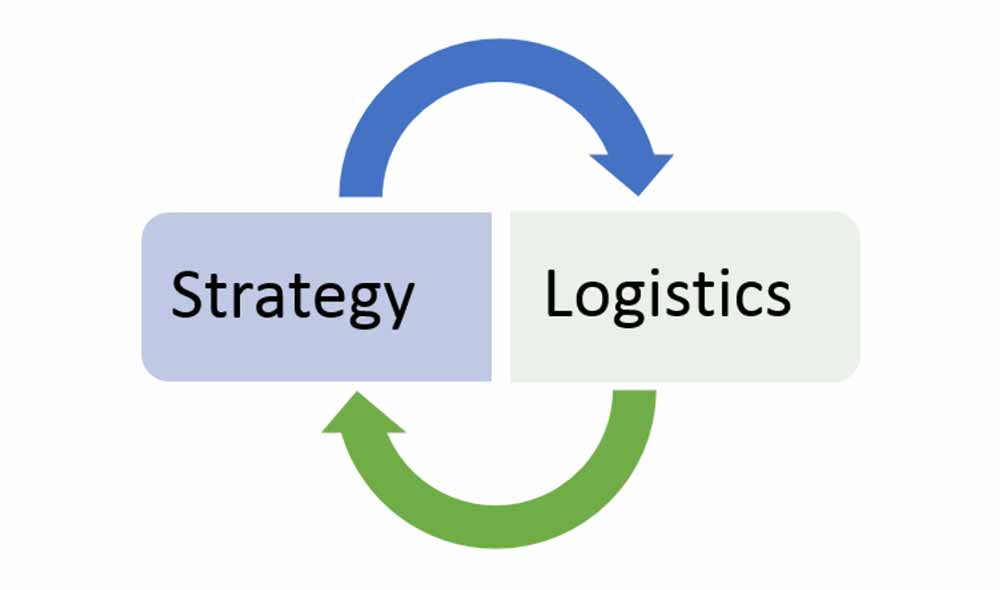The strategy adopted when running a business should include many factors in order to be successful. In this article, we will discuss some of these factors but in particular, the focus will be on the strategic role of logistics in the context of the business strategy and how logistics in business can impact profitability and even a business's chances of survival.
In very simple terms we'll consider what is meant by a strategy but also what logistics in business fundamentally is. We’ll go step by step in explaining how important a strategy is for logistics in business but also how logistics without a strategy is like a ship without a rudder.
To use a metaphor, a supply chain describes the journey raw materials take from source to finished products delivered to your door. If we were to compare that idea to cogs in a machine then logistics would be the buttons you press to make the cogs turn. The logistics strategy would be the instruction that directs you on which buttons to press and in what order.
Press the buttons in the right order and the machine will run smoothly and efficiently. Press them in the wrong order and although the buttons might still work perfectly, there would be delays and additional costs to the whole process. It might have taken you a month to write the instruction manual but long term it will save you time and effort.
The point is in order for businesses to be successful there has to be a plan and there also needs to be a means of executing that plan. This is of particular importance in the field of logistics because once a wheel is set in motion it can be very difficult to stop if you find suddenly that it's going in the wrong direction.

There are 5 important concepts of a business strategy where the effectiveness of each can not be measured accurately without the logistics in business being a major consideration. We’ll look at these five concepts and the way a logistics strategy fits into the bigger picture.
A business strategy is multifaceted but the five concepts; consolidation, standardization, postponement, speculation, and differentiation are key when it comes to planning the logistics in business strategy. Many companies have redesigned their systems and processors to be more aligned with these important concepts but also ensure continual audits help to recognize future opportunities.
So what do all these five concepts have in common other than a specific connection to logistics in business? They all include activities that facilitate the coordination of supply and demand and also the storage maybe in pallet racking and also the movement of products throughout warehouse facilities.
They also include processors in logistics which are difficult to duplicate or transfer from company to company because every company is unique. They also usually require a large investment regardless of the size of the company this is because changes required are usually relative to the size of the company.
Consolidation
A simple example of consolidation is a car share scheme. Typically 3 or 4 people might take separate journeys to and from work and each pays the costs involved. If the circumstances of these people are considered you might find many similarities between each of them.
They may all work on the same days but also travel to the same location. They could start their journey at the same time and also work similar hours. One similarity you can bet they all have is they’d all like to have more money in their pockets.
Through a process of communication, cooperation and collaboration they have a means of reducing costs, saving time, and becoming more efficient. Travel costs could be reduced by 75%, three of the four could reply to emails during the journey so have a less hectic start to the day and also 75% of the group may have more time to spare in the morning.
It would be amiss of me to not also consider possible drawbacks as nothing in life is as straightforward as we would like. One person might like a certain temperature in the car, while another may have a different taste in music. But the point is by managing each of the parties' expectations, a real opportunity exists where each person could benefit.
There are countless ways logistics in business can take advantage of this concept owing to the fact that all businesses have similar goals. Low running costs, high customer services and increased profits, each of which can be maintained or improved through the concept of consolidation. Using shared transportation and storage facilities contributes towards a more consolidated approach to logistics in business.

Standardization
Manufacturers and suppliers have a constant battle on their hands dealing with returns, faults, or product damage. All these issues rely on logistics to minimize the difficulty in dealing with problems as they arise.
If a product is damaged or faulty and a replacement part is required you have two separate items that could be in two completely different locations. These two items have to be assembled together and therefore need to be brought together under one roof.
In order for a manufacturer to be able to quickly replace any part of possibly hundreds of product lines, they would need inventory levels in the thousands. All these items would require transportation, handling, and storage at some point adding up to quite an expense. Standardization looks to reduce costs by utilizing sub-assemblies or modules comprising several components attached together. Modules can be designed making them quick and easy to fit and at the same time, one single module could rectify several different faults which may occur.
Let's look at an example of what benefit this could offer using very simple numbers. Say a manufacturer has a product line that sells 100,000 units per year. Each unit contains 3 components that are prone to wear or failure. If the manufacturer keeps 10% of the units sold of each of the 3 components that would require 30,000 components to be kept as inventory.
Alternatively, let's say the 3 suspect components are assembled together to create a module. 5% of the annual units sold would require 10,000 modules which are equal to 10,000 of each component. The manufacturer still retains 30,000 components but they are condensed into 10,000 units.
The above example would mean that defective components could be quickly replaced at a much lower expense. This situation where fewer items are purchased while retaining large quantities is a technique known as value analysis, this is used to calculate reductions in costs.
Using standard modules instead of smaller components does appear to be a more expensive option. When logistical savings and price discounts are taken into account this more than offsets the extra expense which makes this option more economical overall.
Postponement
The idea of postponement refers to the delaying of order placement for as long as is required to reduce inventory levels. Maintaining inventory is associated with high costs but also poses a risk of accumulating obsolete or unusable stock.
Although this has been just common sense in the past, today's businesses have larger more complex operations so this concept has been leveraged to yield much greater benefits. With the advancement of computer software such as ERP and WMS, this task has become much more manageable.
By utilizing the concept of standardization processors can now be performed further up the supply chain. This enables manufacturers to delay order placement so materials are received just-in-time for immediate use and therefore reducing inventory levels.
Postponement relies heavily on standardization and facilitates a greater availability yet smaller quantities of standard parts or finished component sub-assemblies. Postponement when executed correctly should not have a negative effect on service levels or delivery times but serves to increase efficiency.

Speculation
Speculation could be considered the opposite of postponement. Where postponement serves to delay the receipt of materials, speculation on the other hand aims to increase stock levels. There are many benefits associated with the concept of speculation but it isn’t without risk.
High stock levels are useful as a buffer to protect against fluctuations in supply and demand. When there is a spike in demand, high stock levels can easily absorb the effect. Alternatively, if demand is low then there is a risk of items becoming obsolete and unusable.
Speculation has the added benefit of achieving economies of scale where larger orders can massively reduce the cost of the individual items. Speculation also serves to lower logistics expenditure as fewer deliveries are required.
Speculation and postponement are not mutually exclusive, they are often both utilized in order to attain the benefits of both. Some manufacturers pursue both strategies although they are often utilized at different stages of production or distribution.
Differentiation
Differentiation is the concept of recognizing that different product lines need to be handled in a different way when it comes to logistics in business. By employing a tailored solution based on different categories of products, manufacturers and suppliers can vastly reduce their production costs.
For example, some distribution methods could be more restrictive where the product line is of high value but low in sales volume in nature. This differentiation distribution method would also apply to items when they are out of stock. This approach could massively reduce stock holding costs.
By formally recognizing that different product lines require different logistics methods offers an opportunity to streamline and improve delivery times. Standard stock items may be shipping using traditional surface methods which are predictable and low cost. High-value or out-of-stock items may be packed immediately for next-day dispatch and travel in containers by air.
By utilizing differentiation manufacturers can be confident they have almost complete stock availability in a short period of time. Increased transportation costs can be easily offset against the saving associated with reductions in inventory costs.

Conclusion
Logistics in business must play an important role in the overall business strategy. Logistics systems redesigns must be considered where improvements are found to be possible. Any procedures put in place must be maintained to ensure benefits from the logistics operations can be achieved. A logistics in business audit should be put in place to continually monitor the performance of the system and ensure objectives are being met.







